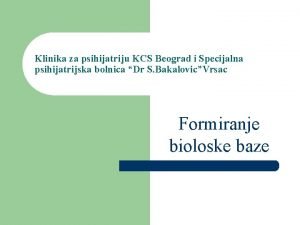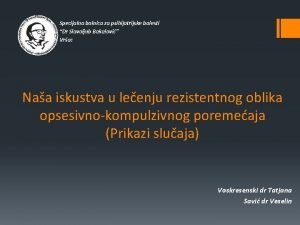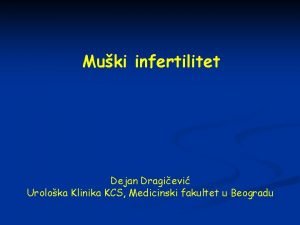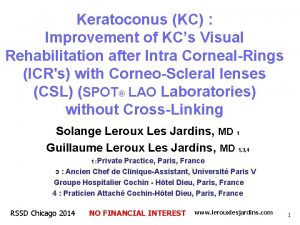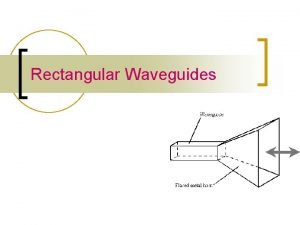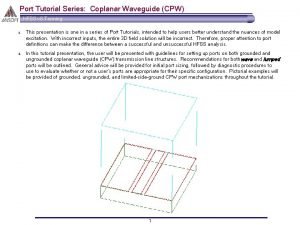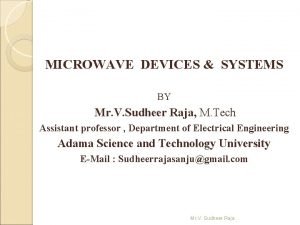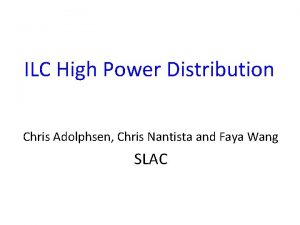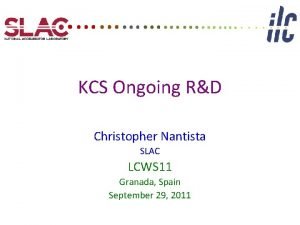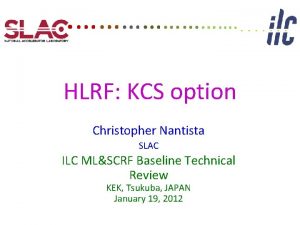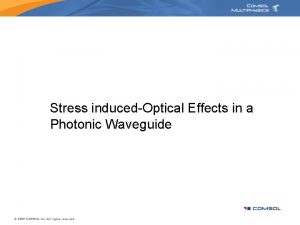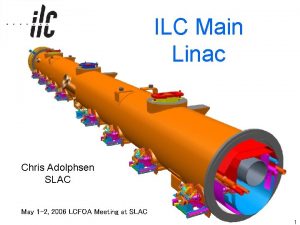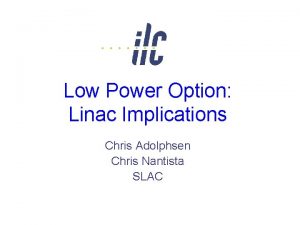KCS Main Waveguide Testing Chris Adolphsen Chris Nantista











- Slides: 11

KCS Main Waveguide Testing Chris Adolphsen Chris Nantista and Faya Wang LCWS 12 Arlington, Texas October 25, 2012

KCS Main Waveguide Testing CTO coupling RF power from P 1 Marx-driven Toshiba MBK into TE 01 mode in resonant line using KEK circulator. Shorted bend with input mode converter at end of run. 40 m of pressurized (30 psig) , 0. 48 m diameter circular waveguide. Recording run data.

Surface Electric Field in Installed Shorted 90 Degree Bend |Es|pk = ~3. 34 MV/m for 37. 5 MW input (= 75 MW full geometry 300 MW TW equiv. at SW anti-nodes) Equivalent to 72 MW TW in WR 650 !

Theoretical Calculations for 40 m Shorted KCS Waveguide + 90 Bend Round trip loss: . 98806*. 99653*. 99991 = 0. 984545 → 1. 545%, field atten. factor: 0. 99224 Round trip delay time: 357. 1 ns exp(-trt/Tc 0) = 0. 99224 → Tc 0 = 45. 8 ms → Q 0 = w. Tc 0/2 = 187, 230 300 MW equiv. field max → P = 75 MW, traveling power (fwd. &bkwd) Stored energy: U = 26. 8 J Input power for beta = 1: Pd = 1. 17 MW

Big Long Pipe w/ Bend* Resonant Cold Test Resonances: fr (GHz) Dfr (MHz) 1. 27559 1. 27831 1. 28105 1. 28380 1. 28657 1. 28934 1. 29214 2. 80 1. 29492 2. 78 1. 29772 2. 80 1. 300516 2. 80 Df = ~2. 794 MHz r 1. 30331 2. 79 1. 30609 2. 78 n = ~340 1. 30889 2. 80 1. 31169 2. 80 1. 31448 Approximately 0. 12 d. B input loss at operating resonance. * minus second transition

Analysis of Nearest Resonance 1. 3005025 GHz fr = 1. 300502 GHz (cold, unpress. ) QL = 78, 839 b = 1. 2997 Q 0 = 181, 310

Combining Measurements with Calculations Input Power (beta =1) : Pd = w. U/Q 0 = 1. 17 MW for 75 MW resonant power (300 MW TW equiv. ) Measured (cold test) b = 1. 300 = 1. 19 MW Or, using measured Q 0 (181, 310): Pd = w. U/Q 0 = 1. 2067 MW Pd = 1. 23 MW (3. 2% lower than predicted) Faya’s high power measurement: At input power of 320 k. W, the reflection is 2 k. W from hp power meter. Therefore, the b = ~1. 17. We need to run the shorted waveguide on resonance with 1. 18 MW input power.

First Run: 1 MW input (255 MW field equivalent – ILC needs only 190 MW initially), no breakdown in 120 hours with 1. 6 ms pulses at 3 Hz

Second Run: 1. 25 MW input (313 MW field equivalent – ILC needs only 190 MW initially), one breakdown in 140 hours with 1. 6 ms pulses at 3 Hz 1. Coupling coefficient β = 1. 17 2. Power needed for equivalent field of 300 MW, Pin = 1. 18 MW.

Breakdown Rate vs E-field (at 30 psig, 200 us)

Breakdown Rate vs Pulse width (at 30 psig)
